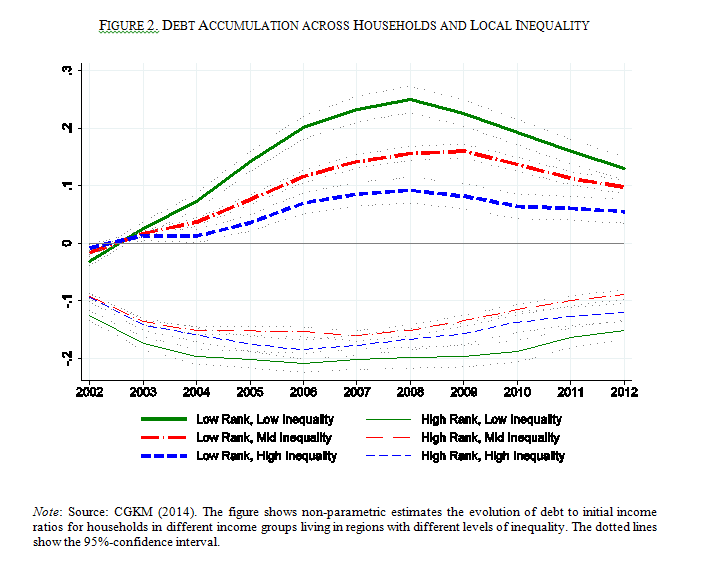"Among non-economists in all countries, the largest concern with inflation appears to be that it lowers people’s standard of living. Non-economists appear often to believe in a sort of sticky-wage model, by which wages do not respond to inflationary shocks, shocks which are themselves perceived as caused by certain people or institutions acting badly. This standard of living effect is not the only perceived cost of inflation among non-economists: other perceived costs are tied up with issues of exploitation, political instability, loss of morale, and damage to national prestige."The first concern is the subject of Noah's mockery. True, some people think in partial equilibrium, neglecting the effects that inflation might have on their nominal income. But it is not an unreasonable concern in some contexts. Nominal wage stagnancy is a reality for many workers. In a 2008 Pew Survey, 57% of respondents believed that their income was rising slower than the cost of living.
In the figure below, the CPI, average hourly earnings for all private sector workers, and average hourly earnings for retail trade employees are all plotted. All are normalized to 100 in 2006. While average hourly earnings for all workers have grown faster than the CPI, the opposite is true for workers in retail. Since 2006, the price level is about 21% higher, but hourly wages in retail are less than 11% higher. They feel poorer and they are poorer.
Did inflation "make them poorer?" Not directly. But the political economy of inflation certainly contributed. Prices and wages do not simply rise or fall on their own. People choose to raise or lower them--this is why prices and wages are in the domain of economics, after all. Who chooses, and how do they choose? That's where things get more complicated. Decision-makers at firms set prices subject to an almost innumerable set of constraints and considerations imposed by the institutional and policy environment they face. Wages are not simply set by some abstract market-clearing condition; they involve bargaining between firms and individual employees or labor unions. Regulations, policy, and social norms also affect the bargaining powers of the relevant groups, with palpable effects on the wage structure.
 |
| Source: http://research.stlouisfed.org/fred2/graph/?g=y1d |
In Japan, for example, deflation has plagued the economy for years. When Shinzo Abe ushered in a return to positive inflation, most Japanese consumers described rising prices as "rather unfavorable." These consumers were not being unreasonable. They were getting poorer! When prices started rising, wages did not. Since the 1950s, Japanese salaries have been determined by coordinated negotiations between unions and large employers. Only very recently, with the backing of Abe, have the unions had sufficient bargaining power to raise salaries in these negotiations. Japan also has a growing informal sector, where already-low nominal wages are unlikely to rise with the price level. Maybe eventually the overall Japanese economy will grow so much that even the low-wage informal workers will be better off. But no one knows how long that could take. Noah says it himself: "Whenever you buy something, the money you spend is someone else's income." But we don't know whose income it will be.
This is not to say that Japanese deflation was a good thing or made people richer. Quite the opposite. But it is to say that people should complain when their cost of living is rising faster than their earnings. Inflation has distributional effects, which will tend to benefit the politically powerful. The people getting the short end of the deal are perfectly rational to be upset about it, especially if their dissatisfaction can be harnessed into political action.
Not only inflation itself, but also inflation risk, has costs and distributional effects. The unpredictability of inflation is part of its cost. Hedging against inflation is theoretically possible but difficult. Inflation risk is costly for its bearers. Our political and economic institutions determine who the bearers will be. When social security and pensions are indexed to the price level, inflation risk to pensioners is reduced, while inflation risk to pension funds increases. When private debt contracts are primarily nominal, an unexpected increase in inflation will be costly for creditors. Indexing sovereign debt to the price level also redistributes inflation risk between countries and their creditors.
The other perceived costs of inflation that Shiller lists--exploitation, political instability, loss of morale, and damage to national prestige--all have historical precedents and are also related to the political economy of inflation. A government that "inflates away its debts" risks imposing any or all of these costs. These costs of inflation are less relevant in the low inflation environments of the United States and much of Europe today. An increase in inflation from, say, 1% to 3% is unlikely to foster political instability or erode national prestige.
In the U.S. today, I think a little more inflation would be a good thing. But I think we also should take seriously the concerns of people whose real income is falling for one reason or another. This boils down to another call for economists to keep worrying about inequality-- even when thinking about issues like inflation.

